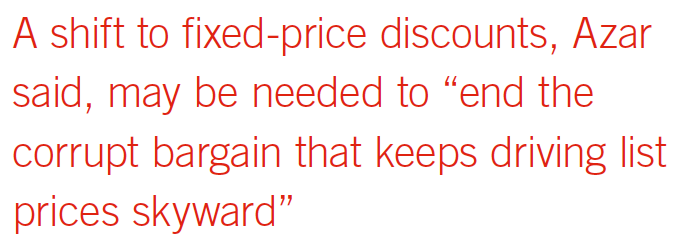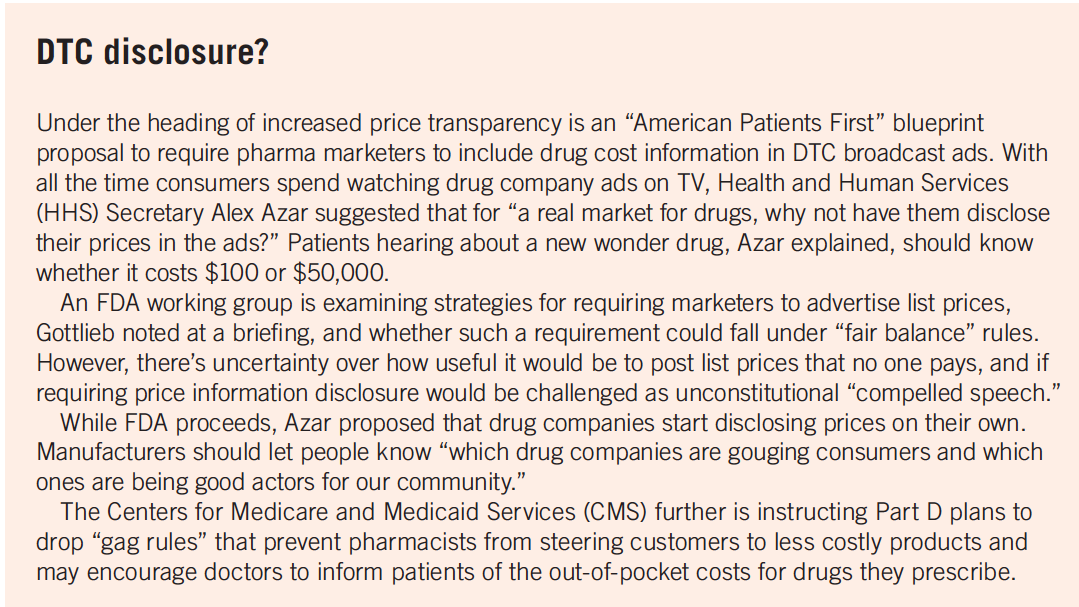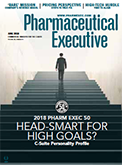US Maps Strategy to Reform Drug Pricing
Pharmaceutical Executive
Azar and Gottlieb out front in revising rebates, restructuring Medicare, and promoting competition.
After months of threats and promises, President Donald Trump finally unveiled his strategy for realizing more affordable prescription medicines in the US. Trump pledged to take on the “tangled web of special interests” that drive up drug prices and chided supply chain middlemen for getting “very rich” under the current system.
The lack of specifics, though, produced a general shrug from industry and the investment community and
Jill Wechsler

visible disappointment from public health activists. The administration’s “American Patients First”
blueprint, unveiled at a May 11 Rose Garden speech, blasts “global freeloading” by industrial nations and proposes major changes in Medicare and Medicaid drug coverage policies, but stops short of authorizing the federal government to directly negotiate Medicare drug prices and or to permit “safe” importation of prescription drugs from other countries, as sought by Democrats and consumer advocates.
Moving Medicare
In further highlighting the important changes to come under the Trump plan, Health and Human Services (HHS) Secretary Alex Azar blasted the Democrats’ approaches as ineffective and unworkable. He emphasized how, instead, the blueprint will achieve such goals by updating Medicare Part B drug coverage and Part D protected classes. This may involve shifting some or all Part B drugs to Part D or revising the Part B payment formula to reflect the wider range of alternative therapies now available in many treatment categories, such as autoimmune disease and inflammatory conditions, as well as cancer, and open the door to Part B price negotiation under new rules. The Centers for Medicare and Medicaid Services (CMS) also may revive the Competitive Acquisition Program (CAP), designed to give physicians an alternative means for reimbursement on Part B drugs.
HHS also is reviewing strategies to gain leverage over prices of drugs covered by Part D, particularly those in the six Part D protected drug classes that account for $30 billion a year in Medicare drug outlays. Proposals include dropping from protected classes those drugs that raise prices too often or too much; permitting coverage of fewer drugs in each class; and authorizing greater utilization management for covered drugs to encourage patient use of less costly medicines.
Less controversial are initiatives to make greater use of value-based payment contracts in Medicare and Medicaid, including a review of whether the Medicaid Best Price reporting requirement blocks such agreements. Reimbursement could vary for additional indications of a drug, and there’s interest in long-term financing arrangements for high-cost treatments that promise important benefits over many years. As a first step towards more price transparency, CMS recently expanded its “Drug Spending Dashboards” for Medicare and Medicaid to highlight information on drugs with high price tags or experiencing notable rate increases.
Rethinking rebates
The administration also is taking a hard look at how the current system of rebates negotiated by pharmacy benefit managers (PBMs) and manufacturers creates perverse incentives for higher list prices. Secretary Azar complained that because PBMs receive a cut of paid rebates, they gain from higher list prices, and that this may encourage plans to manage formularies to gain heftier rebates, rather than to lower net drug costs.
HHS wants to examine how beneficiaries are negatively impacted by such arrangements and how Part D plans could block payments or rebates from manufacturers to PBMs. Related questions are whether PBMs should

receive any remuneration from manufacturers and how such changes would affect manufacturer pricing behavior and insurance and benefit design. A shift to fixed-price discounts, Azar said, may be needed to “end the corrupt bargain that keeps driving list prices skyward.”
FDA Commissioner Scott Gottlieb previewed this discussion in a speech at the May annual conference of the Food and Drug Law Institute, where he cited drug rebates for driving up drug prices to “unaffordable levels for some patients.” He suggested that the federal government may reexamine “the current safe harbor for drug rebates under the Anti-Kickback statute” to help restore “some semblance of reality to the relationship between list and negotiated prices” and boost affordability and competition.
More competition
The blueprint continues to call for more competitive pharmaceutical markets that can put pressure on brand prices by speeding more generic drugs and biosimilars to market. Trump reiterated FDA criticism of brands that block generics makers from access to innovator products needed for bioequivalence testing or stymie negotiations of shared Risk Evaluation & Mitigation Strategies (REMS) required to market competing products. To gain more transparency around these practices, FDA has posted a new database listing about 50 drugs that have received complaints from generics firms about hurdles in obtaining needed test supplies or in REMS participation. The agency also is offering waivers that permit generics firms to create their own REMS if needed. Added competition, moreover, could come from more streamlined approval of over-the-counter drugs and additional FDA guidance to facilitate the development of biosimilars.
Sidebar: Drug Cost Disclosures Looming? Click to enlarge

Moves to enhance market competition at home and to overhaul Medicare drug reimbursement are more likely to alter drug pricing than Trump’s call for other industrial nations to pay more for innovative medicines and end the “global freeloading.” The Commerce Department would identify the “unfair disparity” between drug prices in the US and other developed countries, and the US trade representative would address this “injustice” in talks with trading partners. However, even if the administration could persuade Germany or Canada to increase rates that their citizens pay for medicines, there’s little assurance that pharma companies then would cut prices in the US.
Azar acknowledged that it will take time to make the kinds of “fundamental structural change” in a system of “entrenched market players” that the administration envisions. But he emphasized that President Trump is focused on drug pricing reform and that he expects a visible response from the White House to “the next company that takes a price increase not justified by inflation or change in clinical benefit.”
Jill Wechsler is Pharmaceutical Executive’s Washington Correspondent. She can be reached at jllwechsler7@gmail.com

Navigating Distrust: Pharma in the Age of Social Media
February 18th 2025Ian Baer, Founder and CEO of Sooth, discusses how the growing distrust in social media will impact industry marketing strategies and the relationships between pharmaceutical companies and the patients they aim to serve. He also explains dark social, how to combat misinformation, closing the trust gap, and more.